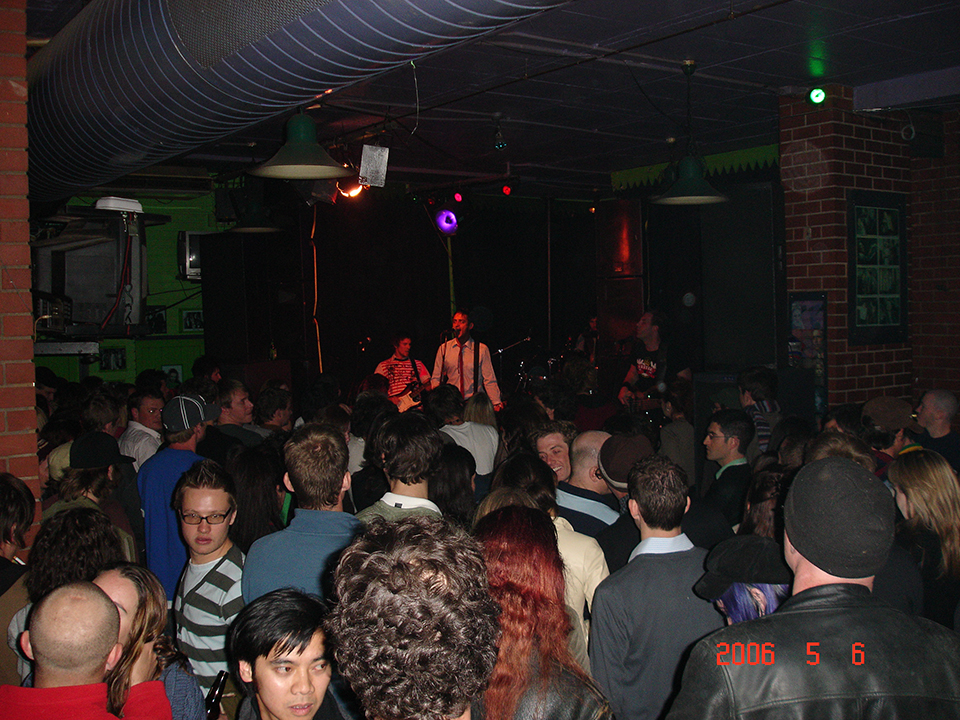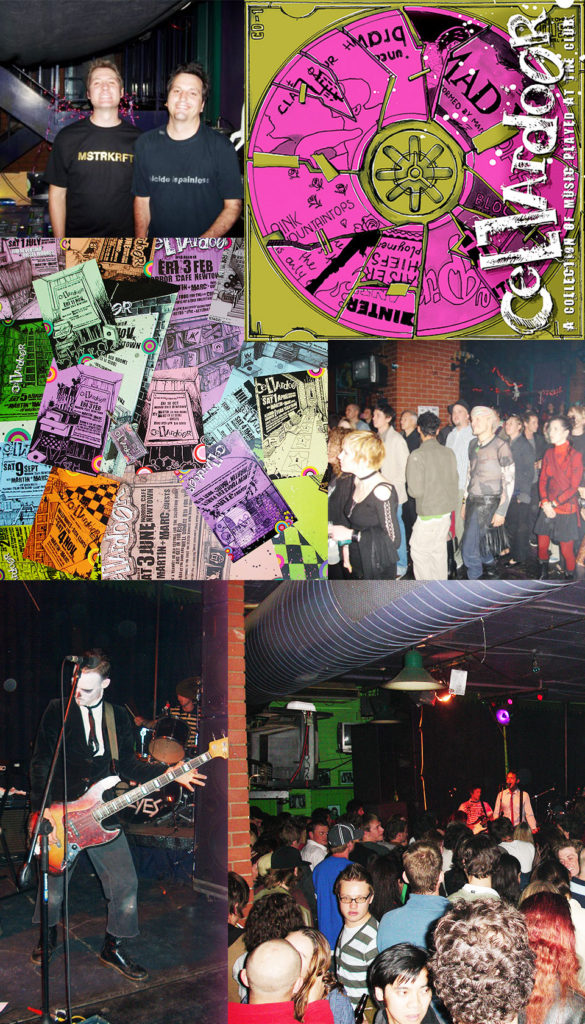‘In two more years, my sweetheart, we will see another view’. Bloc Party lyrics that once punctuated the playlist of a monthly Newtown party called Cellardoor.
The Cellardoor parties ran from 2005 to 2007: a two-year slice in the history of Johannesburg’s nocturnal life. Co-founder, Marc Latilla, holds a catalogue of flyers and photographs from the old parties — a collection of cut-offs and sound bites that document a passing subculture in the city’s after-dark biography. Latilla’s archive speaks to an ephemeral moment, in which a particular time and place — Friday night at the old Horror Café — was captured, monthly, by Cellardoor’s loosely-defined following. Through each iteration, the parties imprinted a particular audio-aesthetic character, spinning all the familiarity and attachment that make times and places meaningful to us.
Cellardoor formed part of an evanescent energy in Newtown’s once-thriving cultural precinct. “Newtown was like a first step back into the city” Marc recalls. “This was before Braamfontein or Maboneng as we know it today”.
Attached to the SAB building on Miriam Makeba St. and decorated with movie memorabilia, was Horror Café, which many posited as the precinct’s epicentre. It was a confluence of artists, musicians, deejays and poets, and a polymorphic genre celebration, playing kwaito, hip-hop, acid house, Afrobeats, and Indie. It was also the original home of Thursday Ragga nights in Newtown, hosted by the incomparable Jah Seed and Admiral.
Chiming with the Horror Café’s cult movie aesthetic, the epochal Cellardoor parties drew thematic inspiration from the psychological horror-science-fiction, Donnie Darko. Co-founders, Marc Latilla and Martin Thomas both loved the film and the soundtrack, which they occasionally spun from the Cellardoor sound system. “It had the right mix of quirkyness, darkness and humour”, Marc says.
Inspired by Donnie Darko’s antihero, the parties were accompanied by a wooden rabbit mascot, dubbed Frank. The name, Cellardoor, was extracted from a scene in the film, where Drew Barrymore’s character, after writing the words ‘Cellar Door’ on a blackboard, turns to Donnie and says, “This famous linguist once said that, of all the phrases in the English language, of all the endless combinations of words in all of history, that ‘cellar door’ is the most beautiful.”
More than a duo of beautifully-strung words, Cellardoor connoted an invitation into a new world, and into the underground. “The Indie & alternative scene has always been underground, so Cellardoor also worked on that level”. The parties mixed new and classic Indie (dating back to the 70s) with alternative music. “We set out to get a good balance between all the new music that was coming out and the stuff we used to dance to at the alternative clubs of old, without becoming a revivalist party. There was always an element of surprise and irreverence in the music choice. We would throw in anything from Wham! to Johnny Cash and tried to stay away from the boring old floorfillers”.

The audience soon came to mirror this generational ecclecticism. “We had girls and guys from the old days”, says Marc, “mixed with the cool kids, all discovering and getting down to what we played”. Eventually, live bands also took to the Cellardoor stage, including acts like Taxi Violence, Wild Eyes and The Dirty Skirts, who were lesser-known at the time. “We would DJ in-between the bands creating a seamless experience. It wasn’t just about watching the bands and then going home”.
Like Donnie Darko, Cellardoor seemed to give rise to a dedicated cult collective, with its own insider-references and artistic identity. The party’s distinctive flyers, for example, were hand-drawn by Marc’s wife, Fiona O’Connor. “If you put all the flyers together from the first to the last, they actually show an intricate underground maze – full of obscure musical references, rabbits and hidden messages”. I’m told that one of the party’s followers collected each and every one of the flyers, which were exhibited as a block at the final party. The now iconic Cellardoor artwork still appears intermittently on social media.
In October 2007, Marc and Martin put on their final co-hosted intallment of Cellardoor. The crowing party doubled as an album launch and featured re-appearances from eight local bands that had graced the Cellardoor stage. This was the second of two Cellardoor albums: the first a collection of international tracks played at the club, and the second a catalogue of all the local bands featured. “Both albums sold out the initial pressings of about 1000 each. It was more for promotion, but people liked the albums”.
Cellardoor was a fleeting subcultural moment — part of a transient time in the city’s history. “Horror Café was a big venue and it became difficult to fill every party. Our attendance numbers were coming down,” Marc remembers. “If I recall, they were also in the process of selling”.
Indeed, the Horror Café, which had run for nine years, would close soon after the Cellardoor parties came to an end. Eventually, other iconic venues like Shivava and Sophiatown would also no longer exist. Many argue that the Junction mall and the influx of new offices suffocated Newtown’s artist precinct. But there are new moments in the making of Newtown’s nocturnal life: And Club, Antidote, Carfax, Shikisha, Gentlemen’s Arthouse, De Peak Bar. Each forms part of a disjointed after-dark cartography — a contested cityscape, discovering itself through jumbled iterations of past and present.
For me, perusing the Cellardoor archive has been very similar to entering a basement of horded everyday memorabilia — a time-warp, catalogueing a party phenomenon from a past decade. Time, its passing, and the possibilities of diving back into the past, are also, interestingly, recurrent themes in Donnie Darko.
“I’m big on re-invention and not doing the same thing over and over. Playing to the same crowd can get incredibly boring especially when you become known for a certain sound. My leaving was to explore this and play wildly different and challenging parties”. ‘In two more years’ Marc did ‘see another view’.
In many ways that is what successful event promotion is about: knowing how to capture time and place, when to let it go, and how to revel in that transcience. While during the day, citydwellers want predictable secure rhythms, at night there is a drive for experimentation and re-imagining. As we decide what the city should look, feel and sound like, and who it should be for, different audiences are at times draw in, and at times alienated. There are evolving, contesting claims to after-dark destinations. Amid all this change, it’s worth paying attention to those moments in which groups of people have cultivated belonging and recognition in a city that always seems to elude us.
“Overall, we lost money doing this!” Marc says. “It was a lot of work, but all worth it for those few throbbing nights where every song we played was cheered. It’s a great feeling when random people preach about something you created”.




















































